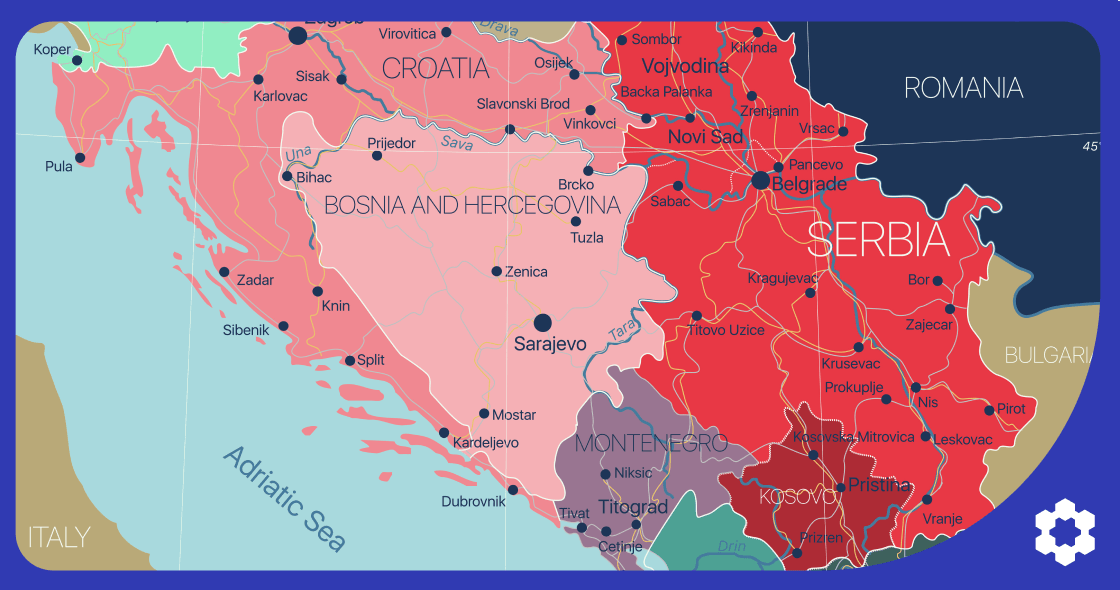In today’s eco-conscious marketplace, sustainability isn’t just a buzzword—it’s a powerful selling point.
Key Insights
Impact
- CPF-badged products see an average 12% sales lift in their first year
- CPF products get 10% more product page clicks, on average
- Amazon has recorded 100 million customer switches to sustainable alternatives
Investment
- Amazon certifications are free; third-party options range from $1,000–$10,000 per product (not ASIN)
- Approval takes roughly 10 days after certification is complete
Opportunities
- CPF badge + Amazon Business listing = access to climate-restricted B2B buying policies (e.g. universities, cities, Fortune 500s)
- Compact by Design can reduce FBA fees by qualifying products for lower tier sizes
- One seller saved $70,000/year on a single product through packaging changes
Consumer behavior is shifting toward sustainability. Amazon has recorded 100 million instances of shoppers switching from conventional products to sustainable alternatives since launching the Climate Pledge Friendly program in September 2020. This mirrors broader trends – Google Trends data shows ‘sustainability’ searches have been steadily rising since 2004, with a notable 12% jump just in the past quarter.
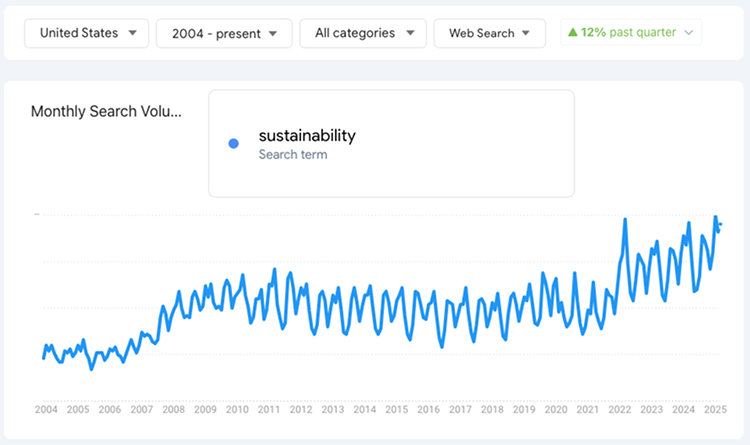
More than a third of global consumers are willing to pay a premium for sustainable products and services, according to the 2021 Global Sustainability Study. With increasing awareness of environmental issues fueled by social media movements like #ClimateEmergency on X, buyers are actively seeking out brands that prioritise sustainability.
Recently, we sat down with Zac Ludington, a nine-year Amazon veteran who leads the Climate Pledge Friendly (CPF) program, to dive deeper into how this initiative is upgrading seller success on the platform. In our interview, Ludington revealed that products with the Climate Pledge Friendly badge see an average 12% lift in sales during their first year after certification—making this “small but mighty leaf” a significant benefit for sellers.
Watch Ludington explain the power of the Climate Pledge Friendly program:
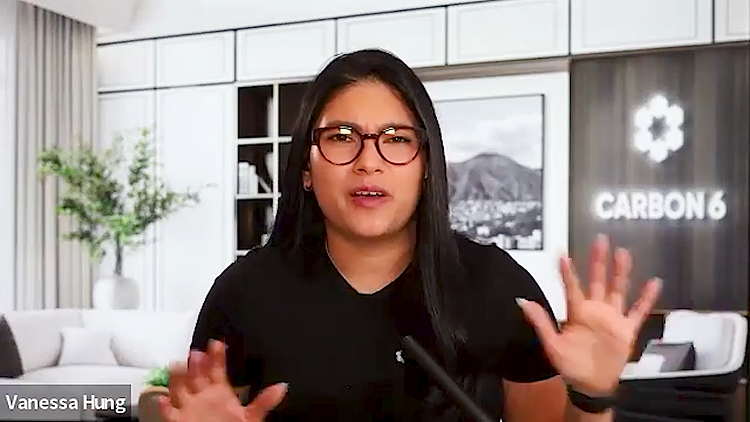
It’s clear Amazon’s Climate Pledge Friendly badge, recognizable by its distinctive leaf icon, has become a coveted symbol for environmentally conscious sellers and shoppers alike. Whether you’re considering developing new sustainable products or transitioning your current lineup, now is the time to go green.
This guide will walk you through the ins and outs of this program, how to earn the badge, and why it’s particularly crucial in certain global markets.
What is Climate Pledge Friendly?
The Amazon Climate Pledge Friendly program is an initiative designed to help customers and businesses discover and shop for more sustainable beauty, fashion, grocery, household, electronics, and office products, among others.
Launched as part of Amazon’s commitment to The Climate Pledge—a promise to be net-zero carbon across their businesses by 2040—this program highlights products that meet sustainability standards and help preserve the natural world.
“This is not just a leaf insert. This isn’t just a badge. This is a comprehensive program that spans all of Amazon’s customer experience, with the intent of helping shoppers to find more sustainable products at scale. We’re in detail pages. We’re in search. We have major peak events around Earth Month and Climate Week. There’s a number of different things—more than ten, actually—that will allow customers to discover your products in a way they otherwise might not have before.“
~Zac Ludington, Amazon Head of Product Strategy & Innovation
Leveraging the “Leaf” Icon to Appeal to Green Shoppers
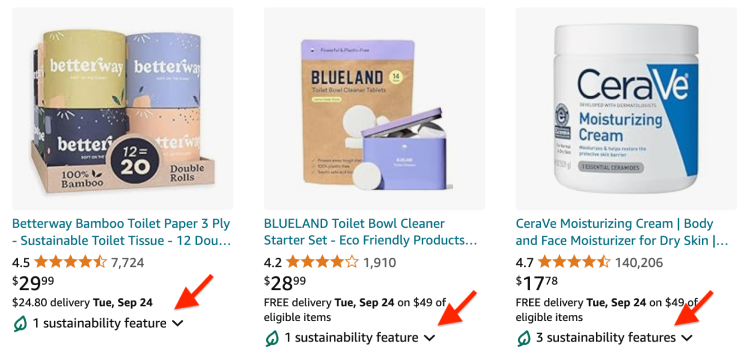
Products in the program are marked with a “Climate Pledge Friendly” badge, represented by a “leaf” icon, indicating that they meet one or more of Amazon’s own certifications, Compact by Design, Pre-Owned Certified, or third-party sustainability certifications.
Beyond just being a symbol, the leaf icon is a powerful visual cue that immediately communicates a product’s sustainability credentials to potential buyers.
This icon appears:
- In search results
- On product detail pages
- Alongside the “sustainability features” label
For many consumers, especially in markets like China, this leaf icon has become a deciding factor in purchasing decisions. More on this later.
Benefits of the Climate Pledge Friendly Badge
Earning the CPF badge can provide several advantages:
Increased Visibility
Products with the badge may appear higher in search results for customers seeking sustainable options. Amazon shoppers can even filter search results to show only products with the badge, which boosts the likelihood of discovery. This visibility is vital, as a survey by Statista shows that 63% of consumers are more likely to purchase products they can identify as eco-friendly. According to Ludington, Amazon has measured an average 10% increase in clicks to a page for products with the Climate Pledge Friendly badge. He notes, “We’re very effectively steering more impressions and more visibility to your products.”
Watch Ludington share the key metrics of the Climate Pledge Friendly program:
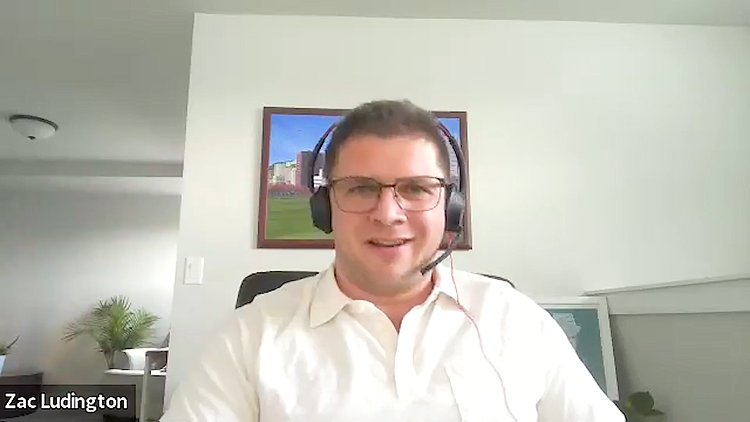
Consumer Trust
The badge lends credibility to your sustainability claims, potentially increasing customer trust and loyalty. As previously stated, the badge is backed by multiple trusted third-party certifications, which ensures that products meet rigorous sustainability standards.
This third-party verification assures consumers that the claims about eco-friendliness are legitimate and not just “greenwashing.” By earning the badge, you demonstrate a commitment to transparency in how your products are made, packaged, and shipped. This transparency builds trust, as 69% of global consumers prefer brands that show concern for environmental responsibility, according to Nielsen.
Competitive Edge
In markets saturated with similar products, the badge helps sellers differentiate their offerings. Sellers who invest in meeting the environmental criteria for the badge stand out as responsible, future-forward businesses. This edge can help smaller or emerging brands compete against larger or existing players that might not yet have similar sustainability certifications.
Market Expansion
The badge helps you expand your market by tapping into the growing demand for eco-friendly products, increasing visibility, and accessing new consumer segments that prioritise sustainability.
Here’s how it can facilitate market expansion:
- Reaching International Markets: The Climate Pledge Friendly badge helps sellers break into new markets, especially in regions where sustainability is a significant purchasing factor. For example, in Europe, sustainability is a key concern, with 68% of consumers in the EU saying they look for environmental labels when shopping (Eurobarometer). Sellers with the badge can therefore appeal to international audiences across diverse markets that prioritise eco-friendly certifications.
- Appealing to Younger Generations: Younger generations, especially Millennials and Gen Z, are particularly attuned to environmental issues, with 73% of Gen Z willing to pay more for sustainable products, according to First Insight. Sellers who display the CPF badge can effectively capture the attention of these younger buyers, many of whom prioritise eco-friendly products and actively seek them out. This badge enables sellers to appeal to a forward-thinking, environmentally responsible consumer base, helping to grow market share among younger demographics.
B2B Market Access
The Climate Pledge Friendly badge unlocks a significant opportunity that many sellers overlook: access to climate-friendly restricted buying policies.
“I think everyone kind of forgets Amazon has a massive business-to-business program called Amazon Business. Cross-listing on Amazon Business means that you don’t just get the Climate Pledge Friendly program, you get the climate-friendly restricted buying policy. What that means is that you have major organizations like universities, cities, Fortune 500 companies that can turn on a switch and say, as an employee, I only want you to buy a climate-friendly product, or I want you to buy this over another product because this is in our policy.”
~Zac Ludington, Amazon Head of Product Strategy & Innovation
This creates a substantial opportunity to access institutional buyers with sustainability requirements. Many large organizations, educational institutions, and government agencies limit purchases to certified sustainable products. With minimal additional effort, your Climate Pledge Friendly certification makes your products discoverable to organizations with sustainability mandates—a relatively simple lift that can open new B2B revenue streams.
The Sustainability Advantage in Different Marketplaces
While sustainability is a global concern, its importance varies across different marketplaces:
China
The leaf icon has become a significant factor in buying decisions for many consumers in China, driven by a growing focus on sustainability and environmental responsibility.
According to the Wunderman Thompson survey, 86% of Chinese internet users are willing to contribute financially to combat climate change. They also believe businesses should drive sustainability and environmental regeneration, demonstrating the nation’s strong commitment to sustainability. This contrasts with lower percentages in the UK (64%) and the US (62%).
The Climate Pledge Friendly leaf icon, which signals that a product meets one or more sustainability standards, resonates well with this demographic.
Additionally, China’s growing emphasis on carbon neutrality—aiming to reach peak carbon emissions by 2030 and achieve carbon neutrality by 2060—has further propelled consumer interest in green products. Brands displaying the Climate Pledge Friendly icon can attract these environmentally conscious consumers, positioning themselves as responsible and future-forward in one of the world’s largest markets.
Europe
Sustainable products are highly significant in Europe, driven by:
- Strong consumer demand: The market for sustainable products in Europe is expanding rapidly. According to a report by Oney, 90% of European consumers consider environmental sustainability when buying products, with an increasing number of eco-friendly items becoming available in the market. In the organic food sector. For instance, Europe leads globally, with organic sales reaching €41 billion in 2022, driven by consumer demand for sustainably sourced and produced foods.
- Stringent regulatory frameworks: European Union (EU) policies strongly support sustainability. The EU Green Deal aims to make Europe the world’s first climate-neutral continent by 2050, and various regulations are in place to encourage sustainable practices. Moreover, the EU Waste Framework Directive mandates the reduction of packaging waste and encourages the use of recyclable materials, pushing companies to adopt more sustainable product designs and practices.
- Growing awareness of environmental issues: European consumers are increasingly influenced by environmental awareness campaigns and sustainability certifications. A study by the EU Commission found that 77% of Europeans are very concerned about climate change and actively seek out products that contribute to environmental protection. This heightened awareness drives the demand for products that are certified as more sustainable.
Products like Patagonia’s sustainable outdoor apparel and Lush’s eco-friendly cosmetics have gained popularity in Europe, demonstrating consumer preference for environmentally responsible brands. H&M also offers a Conscious Collection featuring products made from sustainable materials, catering to the European market’s increasing interest in sustainable fashion.
Overall, sustainable products hold significant importance in Europe, influenced by consumer demand, regulatory support, and a growing focus on environmental responsibility. The expanding market for eco-friendly products and the success of sustainability-focused brands underscore the critical role of sustainability in shaping European consumer preferences and driving market growth.
North America
Sustainable certifications are becoming increasingly important in North America, as both consumer demand and corporate responsibility grow in response to environmental concerns. The rise of eco-conscious purchasing behaviour, coupled with government initiatives and industry regulations, has made these certifications critical for companies aiming to build trust, differentiate their products, and meet market expectations.
Here’s how sustainable certifications are making an impact:
- Rising Demand: In North America, consumer preference for sustainable products has surged in recent years. A Forbes report found that 50% of Millennials and 62% of Generation Z in North America are willing to pay more for sustainable goods. This trend is particularly strong among younger consumers, who purposely search for brands that prioritise eco-friendly practices and products, reflecting a strong preference for sustainable products.
- Impact on Purchasing Behavior: Certified sustainable products have been shown to influence purchasing behaviour across North America. For example, 65% feel they have a moral obligation to use eco-friendly products, and 70% actively seek products with environmentally sustainable production, according to a survey by Agriculture and Agri-Food Canada. This highlights the importance of certifications as tools for building consumer trust and influencing buying decisions.
- Government Initiatives and Certifications: Government-backed certification programs also play a key role in shaping sustainable markets in North America. The US Department of Agriculture (USDA) provides organic certification to products that meet strict agricultural standards, and as of 2020, $62 billion worth of organic products were sold in the US, showing the growing importance of this certification in the food and beverage industry. Similarly, Canada’s EcoLogo, a government-backed environmental certification, is widely recognized for indicating products with minimal environmental impact. This certification has been adopted by numerous industries, including paper, cleaning supplies, and energy-efficient appliances.
- Sustainability Certifications as a Differentiator: In an increasingly competitive market, sustainable certifications serve as a key differentiator for brands. A 2021 IBM and National Retail Federation (NRF) study found that 71% of US consumers consider sustainability when making purchase decisions, and 57% are willing to change their purchasing habits to reduce their environmental impact. Certifications provide an objective, third-party validation that helps brands stand out and capture market share among eco-conscious consumers.
- Environmental Awareness and Social Movements: Social movements and increased awareness of climate change have amplified the importance of sustainable products. In the US, a 2021 Pew Research Center survey found that 60% of adults view climate change as a major threat to the country’s well-being. This heightened awareness has translated into increased demand for products that help reduce environmental impact.
Sustainable certifications are crucial in North America, where consumers, businesses, and governments alike prioritise environmental responsibility. Certifications provide a reliable way for brands to demonstrate their commitment to sustainability, influence consumer behaviour, and comply with regulatory standards. As demand for eco-friendly products continues to rise, sustainable certifications will remain essential in helping brands maintain a competitive edge in the North American market.
Emerging Markets
As awareness grows, sustainable products are gaining traction in emerging markets, presenting an opportunity for forward-thinking sellers.
How to Get a Climate Pledge Friendly Badge on Amazon
To earn the CPF badge, your products must meet at least one of Amazon’s sustainability certifications. Here’s a step-by-step guide:
Review the Climate Pledge Friendly Certifications
Amazon recognizes various third-party certifications and has created its own. Familiarise yourself with these certifications and identify which ones align best with your product category. Log in to Seller Central and then visit the Sustainability Solutions Hub, to learn about the programs and enroll your products.
I wouldn’t recommend anybody spinning up a new sustainability initiative from scratch unless you have a core competency or focus in that area. It’s really complicated. What we want to be able to do is take some of the good work you’re already doing, push you to do more of that work, and then you substantiate the claim in a credible way so we can show it with integrity on the website.”
~Zac Ludington, Amazon Head of Product Strategy & Innovation
Watch Ludington explain how to choose the right certification path:
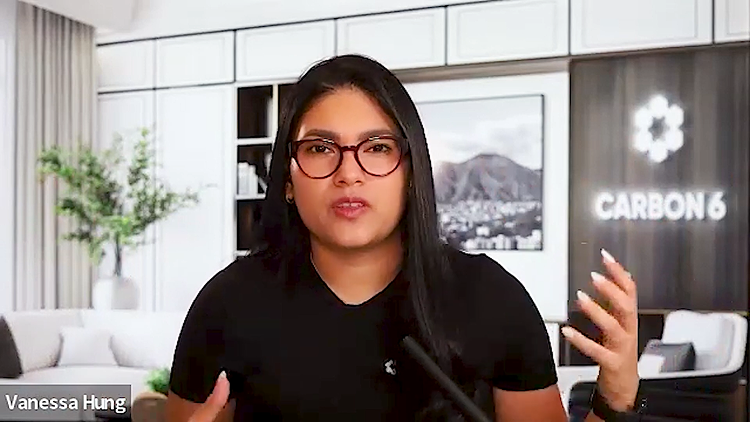
Suppose you sell organic food products, obtaining the USDA Organic certification would be relevant. If your product is energy-efficient, look into GreenCircle Certified: Energy Savings.Alternatively, if you’re aiming to get certified for packaging efficiency, consider Amazon’s own certification program, Compact by Design. Under this program, your products must be designed to reduce their overall environmental impact by minimising excess air and water in their packaging and improving efficiency in product design, which can lead to significant environmental savings.

Amazon then measures this through metrics like packaging volume, weight reduction, or changes that impact the overall shipping footprint. Products that meet these criteria can earn the Compact by Design certification, making them more attractive to eco-conscious consumers. Beyond sustainability benefits, optimizing your packaging for Compact by Design certification can directly impact your bottom line by potentially qualifying your products for a lower (and less expensive) FBA Product tier size. In one case study, a seller’s product resizing and packaging optimization efforts on just a single product resulted in $70,000 in annual FBA fee savings.
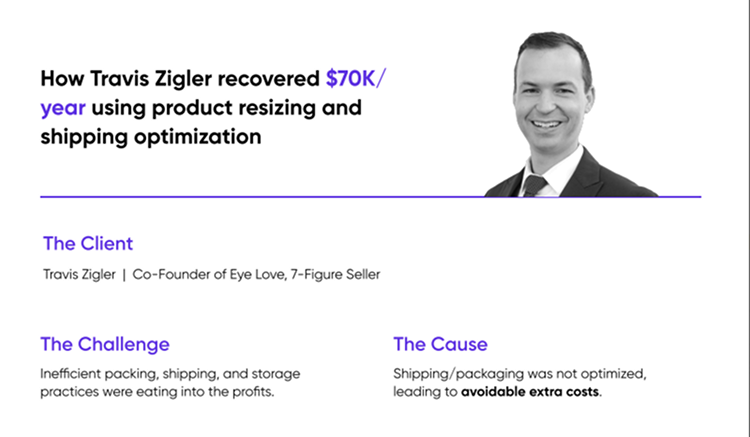
Try Carbon6’s free Product Resizer tool to discover how small adjustments to your product and packaging dimensions can lead to major cost savings.
Obtain Certification
Work towards obtaining the relevant certification for your products. Depending on your product type, third-party certification agencies will evaluate various factors such as sourcing materials, production methods, or energy use. This is why getting certified may also involve changes to your product design, manufacturing processes, or supply chain.
For example, to earn a Cradle to Cradle certification, your product must be assessed across multiple areas, including material health and circular economy potential.
There are also certain certifications that require your products to meet strict environmental or social standards. Fair Trade certified products, for instance, need to support fair wages and safe working conditions, while Rainforest Alliance certification ensures that your product contributes to biodiversity and better livelihoods for farmers. Successfully meeting these criteria allows you to apply for the badge.
If you’re not sure where to start, Ludington notes there are solution providers who can help:
“If you’re completely lost, you don’t want to get started, there are a handful of organizations that we could refer you to—Novi, Terra.do, HowGood, Planet Forward, RESET. These organizations are in the business of helping people figure out which certification match their business best, and then they help you expedite the process, help you lower the cost, and help you operate it in a way that’s more efficient.”
A full list of Amazon’s third-party service provider network is accessible by logging into Seller Central and visiting the Sustainability Solutions Hub.
Other notable certifications include:
- Pre-Owned Certified (Amazon’s own certification)
- Global Organic Textile Standard
- EU Organic
- Ecologo
- Recycled Claim Standard 100
- WaterSense
- Green Seal Certified
- Regenerative Organic Certified
- US Environmental Protection Agency (EPA) Safer Choice Label
- Among other certifications focused on recycled materials and organic products
Apply for the Badge
Once your product has been certified by a third-party agency, you can submit the necessary documentation to Seller Central to have your product marked with the Climate Pledge Friendly badge.
Sellers who have earned the CPF badge report better visibility and higher conversion rates on their product listings.
According to Ludington, the application process takes about ten business days once you’ve completed your third-party certification:
“There’s different upload cadences for different certification bodies, but on our end we try to manage that SLA down as much as possible. I would give it ten business days, because the data pipelines are not in real time and we don’t have APIs with every single certifying body yet, but we’re pushing in that direction.”
Watch Ludington explain the timeline for badge approval:
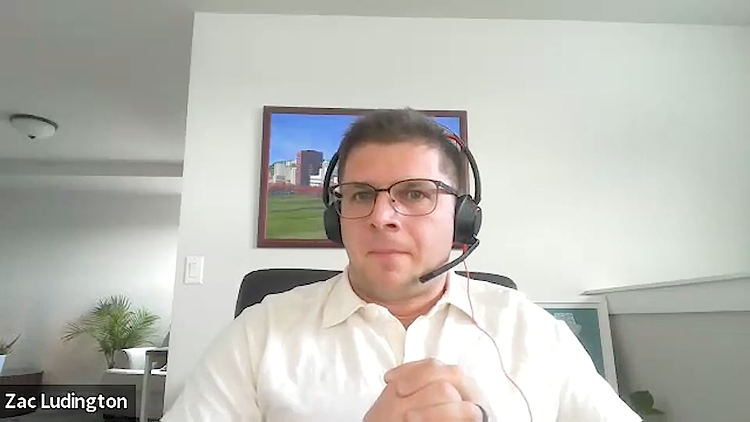
Maintain Compliance
Regularly review and maintain your certification status to keep the badge.
Ludington points out that recertification varies by program: “You will need to recertify. It varies again by certification. On the short end it’s every 12 months. For the long end I’ve seen 3 to 5 year licensing agreements. So just don’t let those lapse.”
Watch Ludington explain recertification and maintaining compliance:
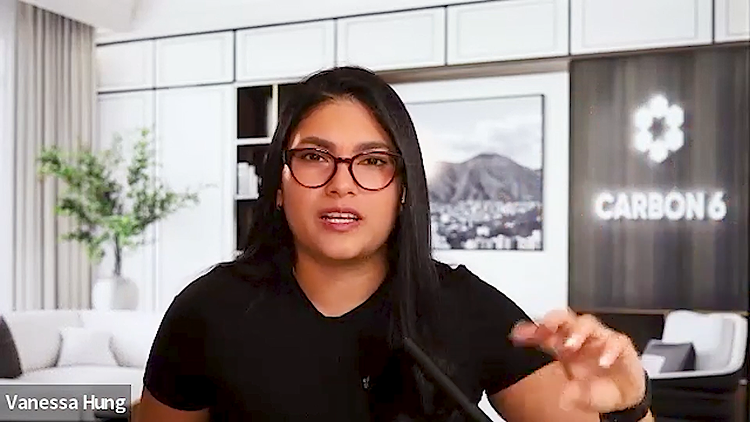
Impact Summary: Key Figures for Seller Sales
Understanding the tangible impact of the Climate Pledge Friendly badge on sales is crucial for sellers considering this certification. Let’s look at some key facts and statistics:
- Sales Boost: According to Amazon, Climate Pledge Friendly products have seen a significant increase in sales. As of 2023, there were 800 million CPF products sold, a 121% increase from 2021.
- Consumer Preference: A Kantar survey revealed that 66% of US customers consider sustainability to be an important factor in their purchasing decisions. This preference directly translates to increased sales for Climate Pledge Friendly products.
- Search Visibility:Increased visibility can lead to higher product views. In 2021, Amazon reported that it shipped over 370 million CPF badged units to customers and found that the addition of the label provides an average 10% increase in page views.
- Conversion Rates: Certified products may have a higher conversion rate compared to similar non-certified products, indicating that the badge not only attracts attention but also influences purchasing decisions.
- Category Impact: The impact varies by product category. For example, according to Momentum Commerce, the badge shows the highest weekly revenue increase in the Patio, Lawn & Garden and Baby Products categories, with boosts of 77% and 36%, respectively. However, in the Cell Phones & Accessories category, the badge has a negative impact, likely because most products carrying the badge are pre-owned or refurbished.
- Customer Loyalty: Recent Amazon post-purchase studies indicate encouraging trends in customer support, brand switching, and repeat purchases, as customers are increasingly choosing participating brands and returning for future purchases.
- Review Ratings: Products with the Climate Pledge Friendly badge tend to receive higher customer ratings, with an average increase of 0.2 stars compared to similar non-CPF products.
- Brand Perception: A study found that customers with a high level of ecological motivation view brands with green products more favourably, which can lead to increased brand value and customer loyalty.
Ludington shares three critical numbers that showcase the program’s effectiveness:
“There’s three numbers everyone should take home with them. Number one: 100 million. Number two: 10%. Number three: 12%. Let’s start with 100 million. So to measure efficacy of this program, our goal isn’t to sell more products. Our goal is to sell better products, to sell more sustainable products. There have been 100 million customer switches since this program started. The second number, the 10%—we’ve been able to historically measure an average of 10% glances to your leaf. That’s clicks to your page over those three years as well. And then third number: 12%. On average, sellers see a 12% lift on a product for the first year after they received the badge.”
Challenges and Considerations
While the benefits are significant, there are challenges to consider:
Rigorous Standards
There are currently over 50 certifications, such as Fair Trade Certified, Carbon Trust, Cradle to Cradle, and Bluesign®. Each of these certifications has specific and often rigorous standards that require products to meet environmental and social responsibility benchmarks, which can be difficult for sellers to achieve.
Some may also find it challenging to identify the right certification for their products. For example, a beauty brand seeking the Cradle to Cradle certification must meet stringent requirements on material health, reuse, renewable energy use, and water stewardship.
Consider investing time and resources into understanding the certification requirements relevant to your products. Researching the right certification, preparing the necessary documentation, and making product adjustments are time-consuming but essential steps.
Certification Costs
Achieving a sustainability certification is not just a matter of applying–it often requires a substantial investment of time and money.
Each certification body has its own application process, which can include audits, product testing, and ongoing compliance monitoring. Additionally, some certifications require sellers to overhaul certain aspects of their product or packaging design, such as using more sustainable materials or adopting more energy-efficient production methods.
Many small to mid-sized sellers may lack the financial resources or time to invest in this process. The certification costs vary widely, from a few hundred to several thousand dollars, depending on the certifying organisation and the complexity of the product’s environmental impact.
Regarding costs, Ludington provides a realistic range:
“On average, when it comes to certification costs, you’re generally looking at around $1,000 for products in consumable categories. For hardlines categories, costs can reach up to $10,000 per product certification. It’s worth noting that ‘product’ doesn’t necessarily mean individual ASINs or SKUs. If you have similar product variations, the certification process can be more efficient. Certifiers often offer reduced rates or batch auditing for similar items, which can significantly lower your per-product costs.”
Watch Ludington discuss certification costs and ROI considerations:
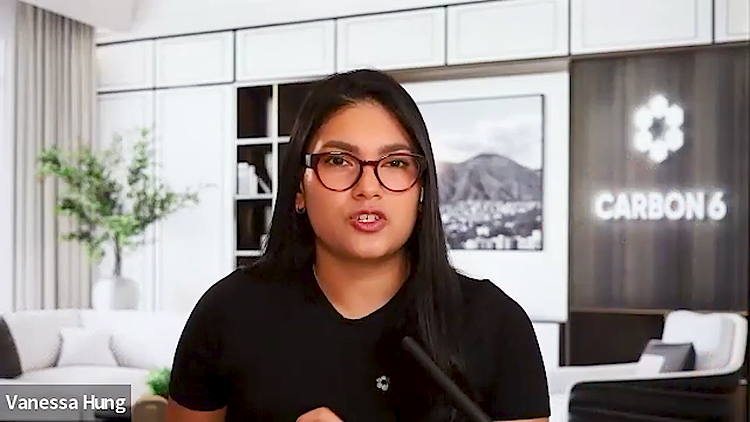
Calculate the return on investment (ROI) of acquiring a certification. In some cases, the costs of certification can be prohibitive, particularly for small businesses. Be sure to weigh the long-term benefits of being able to market products as eco-friendly and gaining access to the Climate Pledge Friendly badge.
It’s also worth noting what Ludington mentions about cross-marketplace benefits:
“It’s not just us doing this anymore. There’s a Walmart program, there’s a Target program, I’ve heard a host of other retailers mention that. So that might also be another thing for sellers to be mindful of—that $10,000, it’s not going to necessarily be just for one forum. It might actually be something that highlights you in multiple programs. It differentiates you in a really meaningful way.”
Supply Chain Transparency and Traceability
Many sustainability certifications require sellers to demonstrate complete transparency and traceability throughout their supply chains. Certifications such as Fair Trade and Rainforest Alliance require proof that products are made ethically and sustainably, often involving multiple stages of the supply chain, from raw materials to final production.
Supply chain transparency can be difficult, particularly for sellers who rely on third-party suppliers or operate in regions with limited oversight. Ensuring that every link in the supply chain adheres to environmental and ethical standards can require sellers to reassess their current suppliers or even switch to new ones, which can be disruptive and costly.
For example, a company that manufactures textiles might need to ensure that its cotton is sourced from certified organic farms, and that every processing facility adheres to strict environmental guidelines. This level of oversight and reporting may involve multiple suppliers and add complexity to the procurement process.
Prioritise partnerships with suppliers who can demonstrate compliance with certification standards. Developing long-term relationships with sustainable suppliers is crucial for maintaining certification status and securing the Climate Pledge Friendly badge.
Environmental Impact of Packaging
Packaging plays a critical role in securing a Climate Pledge Friendly badge, as Amazon’s Compact by Design certification specifically evaluates the efficiency of product and packaging design. Products with more sustainable, efficient packaging can qualify for the CPF badge, but achieving this requires significant changes for many sellers.
Redesigning packaging to be more eco-friendly often involves reducing material use, increasing recyclability, or shifting to biodegradable alternatives.
For example, switching to compostable or recyclable packaging might involve new materials, suppliers, and potentially higher costs. It could also impact the product’s appearance or perceived value to consumers, particularly in industries where premium packaging is essential.
Weigh the balance between reducing packaging waste and maintaining product protection, aesthetic appeal, and affordability. Using tools like Carbon6’s Product Resizer and Master Carton Calculator to optimise packaging dimensions and reduce environmental impact can help streamline this process.
Ongoing Compliance
Once a product earns the Climate Pledge Friendly badge, maintaining it requires ongoing compliance with certification standards. Certification bodies typically perform regular audits and reviews to ensure that products continue to meet sustainability criteria. You must be prepared to maintain documentation, perform necessary tests, and implement updates as certification requirements evolve.
Keeping up with ongoing compliance can be resource-intensive, particularly for businesses that manage multiple certifications or a large product portfolio. For instance, sellers with the USDA Organic certification must ensure that their entire production process—from sourcing to labelling—remains compliant with organic standards, even if it introduces new suppliers or changes its product formulation.
Establish clear internal processes for monitoring certification compliance, including appointing dedicated personnel to handle certification audits, documentation, and updates. Staying proactive in managing compliance will prevent the risk of losing the CPF badge.
Market Variations
While earning the Climate Pledge Friendly badge can provide a competitive edge, not every product category will experience the same level of impact.
Some categories, such as household goods, food, and apparel, may benefit more from sustainable certifications, as consumers in these areas are increasingly looking for eco-friendly options. However, in categories where sustainability isn’t yet a major purchasing factor, you may not see immediate benefits from earning the badge.
Watch Ludington discuss high-opportunity product categories:
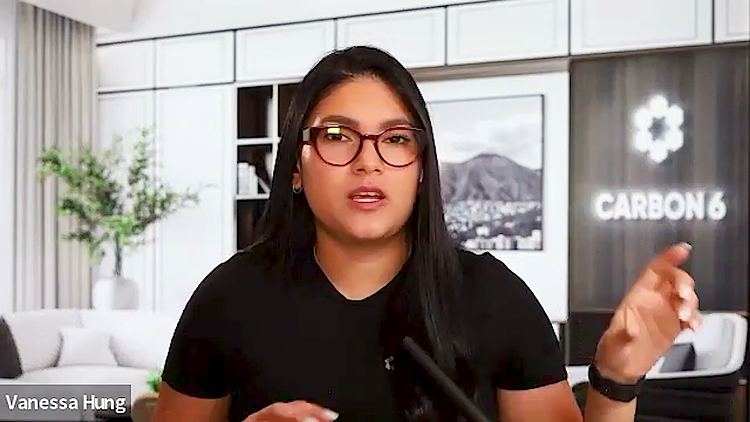
Assess whether the target market values sustainability certifications. If a product’s category or customer base doesn’t prioritize eco-friendliness, the time and expense of obtaining the CPF badge might not result in a significant sales increase.
Consider conducting market research to determine the importance of sustainability in your specific product category. While you may benefit greatly from certification, other sellers might see a slower return on investment.
Amazon Sustainability as a Strategy
The Climate Pledge Friendly badge represents a significant opportunity for Amazon sellers to differentiate their products and tap into the growing market for sustainable goods. While earning and maintaining the badge requires effort, the potential benefits in terms of visibility, consumer trust, and market expansion make it a worthwhile consideration for forward-thinking sellers.
Remember, sustainability isn’t just good for the planet—it’s increasingly good for business too. As you navigate your Amazon selling journey, consider how the Climate Pledge Friendly program might fit into your strategy for long-term success.As Ludington notes about Amazon’s vision: “We want to be the most trusted shopping destination for more sustainable products, and we’re going to need your help with that.”
Watch Ludington discuss the future of the Climate Pledge Friendly program:
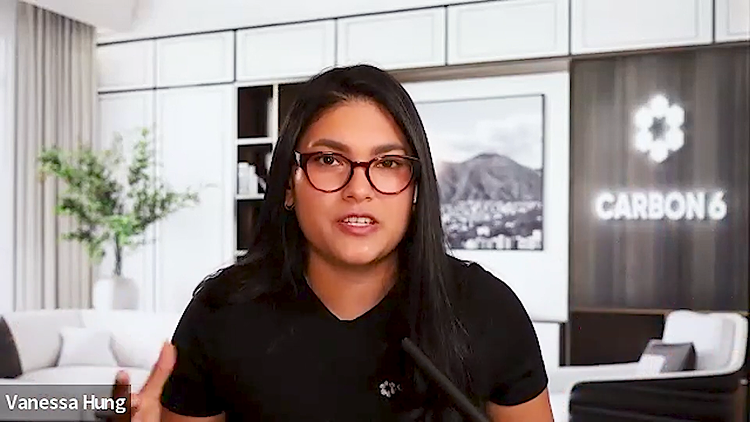
The statistics and facts presented here demonstrate that this badge can have a substantial positive impact on seller sales and brand perception. However, results may vary depending on factors such as product category, target market, and overall brand strategy. Sellers should weigh these potential benefits alongside the costs and efforts required to obtain and maintain the certification when deciding whether to pursue the Climate Pledge Friendly badge.
Keep your team informed with our weekly Amazon Seller Newsletter. With over 200 issues published, it’s your go-to resource for critical updates on policy changes, announcements, and community events. Subscribe or share with your team to get seller news delivered weekly.


